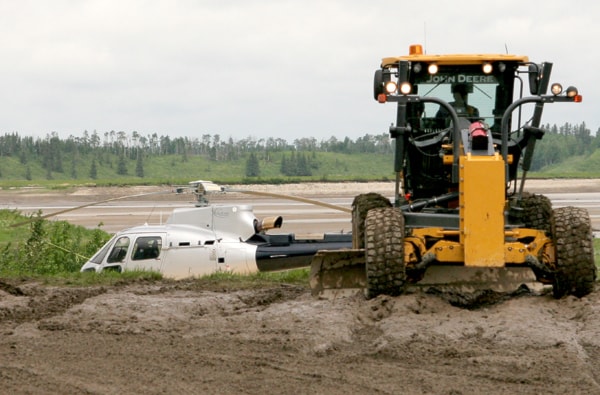Wind and rain are both friend and foe in the efforts to clean up after an oil spill on the Red Deer River, says the man on point.
Over the weekend, crews working for Plains Midwestern Canada strung a pair of containment booms across the Gleniffer Lake reservoir and have started skimming oil from the lake surface, vice-president of crude oil operations Stephen Bart told reporters during a press conference on Sunday.
Skimming operations were delayed on Sunday because high winds made the lake too dangerous for crews to operate their boats, said Bart.
Cleanup operations are running around the clock with up to 100 people on site at any given time.
Earlier on, the wind had actually helped contain the slick in the southwest corner of the lake while crews worked to get it corralled behind the first boom, he said. A second boom was placed further down the lake in case there was a problem with the main boom, he said.
Whether high water in the days leading up to the leak is still unknown.
Bart estimated that up to 3,000 barrels of crude oil had leaked before a 10-kilometre section of pipeline that runs under the Red Deer River was plugged at its confluence with Jackson Creek, about 30 kilometres upstream from the dam.
Bart said he still doesn’t know what caused the leak. Investigators have not yet been able to get a look at the pipe where the leak occurred.
The company’s first priorities have been to contain the leak and get the oil cleaned up, starting with the lake, said Bart.
Heavy rains and high waters have actually helped flush the oil into Gleniffer Lake, where it is more easily contained and picked up along with the debris that has come with it, he said.
There has been no assessment so far of the impact on wildlife. Various devices have been placed to ward animals and birds away from the affected area and people are walking the river’s edge to search for injured wildlife.
Bart said he hopes to enlist local groups to help walk the river and assess the damage.
“Plains wants to ensure landowners that we are doing everything we can to minimize the potential impact that this incident may have on them and we are doing everything we can to clean it up as quickly as possible and to restore the water and the land,” he said.
At the opposite end of the lake, Dickson Dam operations manager Colin Soehn said he and his coworkers are performing a balancing act to keep the spillway flowing while leaving some headroom in case of a breach in the boom.
During seasons of high flow, water is held in the dam and regulated through the spillway to prevent floods downstream.
The spillway had to be shut twice so far during the cleanup so crews could string their booms, said Soehn. The second shutdown was necessary after one of the booms failed and had to be redone, he said.
As of late Sunday morning, the spillway was releasing at 350 cubic meters per second, which is a normal rate for June and about the same rate at which river water was entering the the lake. Levels are being maintained at about 4.5 metres below full.
But how long that bit of headroom would last if the spillways had to be shut down again would depend on the weather.
If the dam started to fill, the spillway would have to be opened regardless of any oil in the reservoir, said Soehn.
While Bart was unable to say how long it will take to finish cleaning up the spill, it appears that the lake will be off limits to recreational users for the better part of the summer.
Recreational user Andrew Van Oosten and his friends had hoped to go fishing Saturday but were told by Alberta Environment officials to stay away from the water.
“You are not allowed to go near the water because it (oil) is washing up on shore. I hope it just passes by in a week or two.”
Gleniffer Lake Resort operator Randy Westergaard is doing his best to deal calmly with a calamity that came as residents prepare for the summer season. The marina has been closed until further notice, as have a number of campsites in the area.
The resort includes 750 recreation lots and permanent homes of people attracted to the water.
Westergaard credits the company for moving quickly to deal with the mess, including trucking in drinking water to the resort.
“All I can say is that Plains Midstream stepped up to the plate immediately and as far as I can see are doing everything in their power,” he said.
“Who is to blame? The government are the ones who gave them approval in the first place. It’s unfortunate it had to happen.”
Alberta Premier Alison Redford said on Saturday that the co-ordination to deal with the spill has been moving quickly.
“There was some concern that if the weather was difficult today that there might be a challenge,” Redford said.
“My understanding is the weather hasn’t impacted it and everything is on course.”
“We’re seeing some good containment.”
Redford has promised a full investigation and said if there are safety shortfalls the government will make changes.
This is Plain’s Midstream’s second recent spill in Alberta in just over a year. In April of last year a company pipeline in northwestern Alberta ruptured, leaking more than 4.5 million litres of oil. A company statement issued last week said cleanup efforts near that spill are almost complete.
Alberta Environment officials are on scene with equipment to monitor air quality and municipalities along the spill site are sampling water to check for contaminants.
bkossowan@www.reddeeradvocate.com
